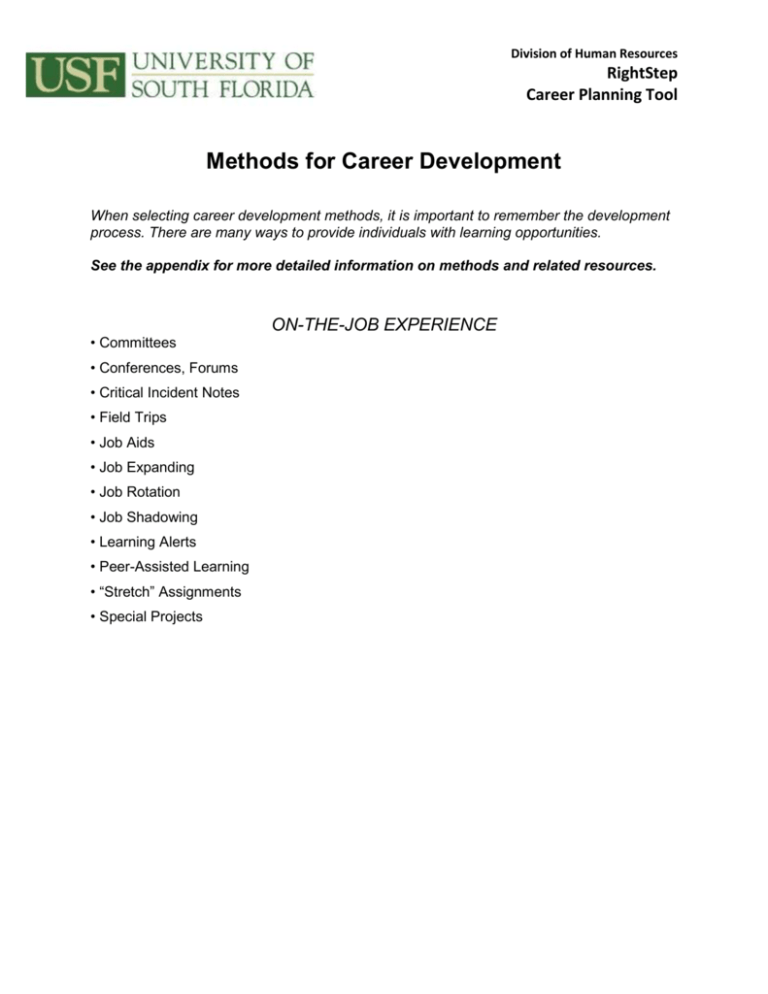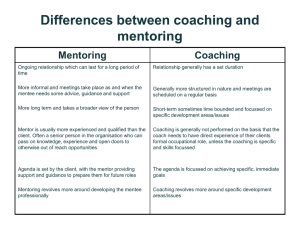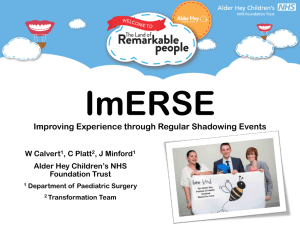Methods for Career Development
advertisement

Division of Human Resources RightStep Career Planning Tool Methods for Career Development When selecting career development methods, it is important to remember the development process. There are many ways to provide individuals with learning opportunities. See the appendix for more detailed information on methods and related resources. ON-THE-JOB EXPERIENCE • Committees • Conferences, Forums • Critical Incident Notes • Field Trips • Job Aids • Job Expanding • Job Rotation • Job Shadowing • Learning Alerts • Peer-Assisted Learning • “Stretch” Assignments • Special Projects Division of Human Resources RightStep Career Planning Tool RELATONSHIPS AND FEEDBACK • Coaching • Mentoring • Networking • Performance Appraisal CLASSROOM TRAINING • Courses, Seminars, Workshops OFF-THE-JOB LEARNING • Courses Offered by Colleges/Universities • Professional Associations • Reading Groups • Self-Study Division of Human Resources RightStep Career Planning Tool Methods and Resources for Career Development Employee development needs to suit your organization's context, job descriptions, employment contracts and collective agreements. When selecting employee development methods, it is important to remember the learning process. There are many ways to provide employees with learning opportunities. Development Method On-The-Job Experience Committees Committees are part of everyday activity in any organization. They can also be effective learning tools, with the right focus. Committees made up of staff from different areas of your organization will enhance learning by allowing members to see issues from different perspectives. Set aside part of the committee's work time to discuss issues or trends that may have impact on the organization in the future. Conferences, Forums Employees can attend conferences that focus on topics of relevance to their position and the organization. Upon their return, have the employee make a presentation to other staff as a way of enhancing the individual's learning experience and as a way of enhancing the organization. (Some conferences and forums may be considered off-the-job learning.) Critical Incident Notes Day-to-day activities are always a source of learning opportunities. Select the best of these opportunities and write up critical incident notes for staff to learn from. Maybe a client complaint was handled effectively. Write a brief summary of the incident and identify the employee's actions that led to a successful resolution. Share the notes with the employee involved and with others as appropriate. If the situation was not handled well, again write a brief description of the situation identifying areas for improvement. Discuss the critical incident notes with the employee and identify the areas for the employee to improve upon and how you will assist the employee in doing this. Field Trips If your organization has staff at more than one site, provide employees with an opportunity to visit the other sites. This helps your employees gain a better understanding of the full range of programs and clients that your organization serves. Field trips to other organizations serving a similar clientele or with similar positions can also provide a valuable learning experience. Give staff going on field trips a list of questions to answer or a list of things to look for. Follow up the field trip by having staff explain what they have learned and how they can apply that learning to your organization. (Field trips can also be an off-the-job activity.) Job Aids Tools can be given to employees to help them perform their jobs better. These tools include: manuals, checklists, phone lists, procedural guidelines, decision guidelines and so forth. Job aids are very useful for new employees, employees taking on new responsibilities and for activities that happen infrequently. Job Expanding Once an employee has mastered the requirements of his or her job and is performing satisfactorily, he or she may want greater challenges. Consider assigning new additional duties to the employee. Which duties to assign should be decided by the employee and his or her manager? Organizations with flat organizational structure are starting to give some managerial tasks to experienced staff as a way of keeping those staff challenged. Division of Human Resources RightStep Career Planning Tool Development Method Job Shadowing If an employee wants to learn what someone else in your organization does, the employee can follow that person and observe him or her at work. Usually the person doing the shadowing does not help with the work that is being done. Learning Alerts Newspaper articles, government announcements and reports can be used as learning alerts. Prepare a brief covering page, which could include a short summary and one or two key questions for your employees to consider. Then, circulate the item. Include the item on the agenda of your next staff meeting for a brief discussion. Orientation Introducing a new employee to the organization, its mission, its activities and programs, its clients and key staff are all part of orienting the new employee to the workplace. An orientation session is often the basis for an employee handbook. The handbook serves as a ready reference to the material covered during the orientation session. The orientation of new employees can provide a great refresher or learning opportunity for their colleagues, who can be asked to present information or guide the newcomer. On-Boarding Broader than Orientation listed above. On Boarding includes orienting new staff to place, people and plans. May include a preceptor or buddy system, series of meet and greets with key individuals, job shadowing, etc. Peer-Assisted Learning Two employees agree to help each other learn different tasks. Both employees should have an area of expertise that the co-worker can benefit from. The employees take turns helping their co-worker master the knowledge or skill that they have to share. “Stretch” Assignments These assignments give the employee an opportunity to stretch past his or her current abilities. For example, a stretch assignment could require an employee to chair a meeting (if the person has never done this before). To ensure that chairing the meeting is a good learning experience, the manager should take time after the meeting to discuss with the employee what went well and what could have been improved. Special Projects Give an employee an opportunity to work on a project that is normally outside his or her job duties. For example, someone who has expressed an interest in events planning could be given the opportunity to work as part of a special events team. Relationships and Feedback Coaching Coaching refers to a pre-arranged agreement between an experienced manager and his or her employee. The role of the coach is to demonstrate skills and to give the employee guidance, feedback, and reassurance while he or she practices the new skill. Mentoring Mentoring is similar to coaching. Mentoring occurs when a senior, experienced manager provides guidance and advice to a junior employee. The two people involved have usually developed a working relationship based on shared interest and values. Networking Some professional specialties have informal networks designed to meet the professional development need of the members. Members meet to discuss current issues and to share information and resources. Performance Evaluations Performance evaluations are partly evaluation and partly developmental. In traditional performance evaluations, the manager and employee evaluate the employee's strengths and weaknesses. The results of an evaluation can be used to identify areas of further development for the employee. Classroom Training Courses, Seminars, Workshops These are formal training opportunities that can be offered to employees either internally or externally. A trainer, facilitator and/or subject matter expert can be brought into your organization to provide the training session or an employee can be sent to one of these learning opportunities during work time. Division of Human Resources RightStep Career Planning Tool Development Method Off-The-Job Learning Courses Offered by College/Universities At USF, employees can take advantage of the Employee Tuition Program. Employees may attend these classes on their own time or your organization may give them time off with pay to attend. Professional Associations Professional associations provide employees an opportunity to stay current in their chosen field. Reading Groups (Also called Learning Circles or Reading Circles) A group of staff meets to discuss books or articles relevant to the workplace/organization. Meetings usually take place outside normal working hours, such as lunch time or right after work. Off-The-Job Learning Self Study Self-paced independent reading, e-learning courses, and volunteer work all provide learning opportunities. The employee engages in the learning activity by choice and at his or her desired pace of learning.





